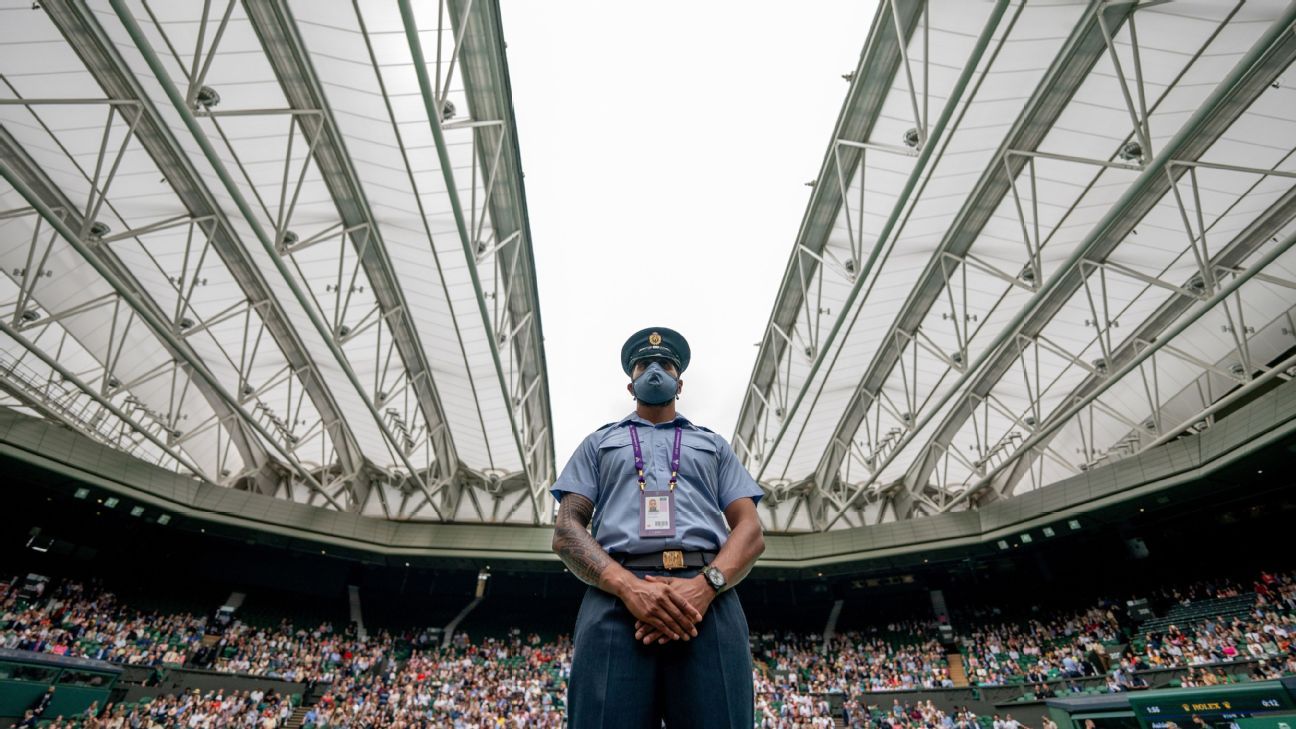LONDON — Shortly before Roger Federer stepped out to play his first-round match at Wimbledon on Tuesday, a voice popped up on social media.
Hello @rogerfederer, my old friend. I’m here to help you one last time if you need me… #rogersroof
— Wimbledon Roof (@WimbledonRoof) June 29, 2021
The voice was the Twitter account of the Wimbledon Centre Court roof, a tongue-in-cheek offering that began back in 2012, three years after the roof itself was officially opened. As the Twitter profile reads: “The famous Wimbledon Roof. Open when it’s raining, closed when it’s sunny — the source of discussion whatever the weather…”
Built at significant expense to the All England Club — the New York Times reported its cost in 2009 to be around $165 million — the roof was a hot topic over the first two days of this year’s event, thanks to inclement weather and a number of high-profile slips.
While the Centre Court roof — and its newer counterpart on Court No. 1 (which opened in 2019 at a reported cost of $85 million) — has allowed play to continue, it also possibly contributed to a number of players slipping and suffering injuries.
Serena Williams, the seven-time champion, left the court in tears after aggravating a hamstring injury while Federer’s opponent, Adrian Mannarino, retired after one point of the final set after injuring his knee.
Neil Stubley, the head groundskeeper at the All England Club, told Wimbledon’s radio channel Wednesday that it was the first time the roof had been closed on the first day of the event.
Stubley added that the slightly reduced airflow on the court, when the roof is closed, may have contributed to making conditions slightly more slippery than if the roof was open.
Federer said after his first-round match he felt conditions were different when the roof was closed.
“I do feel it feels a tad more slippery maybe under the roof,” Federer said. “I don’t know if it’s just a gut feeling. You do have to move very, very carefully out there. If you push too hard in the wrong moments, you do go down. I do feel it’s drier during the day. With the wind and all that stuff, it takes the moist out of the grass.”
For the first time in two long years, we have tennis under my watchful gaze. Let’s do this… #tennisroof https://t.co/6ryua7lnIS
— Wimbledon Roof (@WimbledonRoof) June 28, 2021
For decades, Wimbledon was known for rain as much as for grass-court tennis and strawberries and cream. The British summer often forced fans to scramble for cover as the grounds staff rushed on to pull the protective covers over the court.
Play was interrupted at Wimbledon at various times over the years.
In 1982, only half of the 365 matches scheduled for the first week were completed because of bad weather and since World War II, 15 full days have been completely washed out.
After years of procrastinating, Wimbledon relented and a new retractable roof opened to much fanfare, only for it to barely be used in the first few years, including just once in 2009.
The match between former champion Amelie Mauresmo and Dinara Safina that year was paused due to rain and then finished under the roof. Andy Murray then beat Stan Wawrinka in the first full match under the roof, finishing at a then-record late time of 10:39 p.m.
Wimbledon did not get much of a return for its money in the opening few years, as the British weather stubbornly refused to play ball.
According to the Wimbledon Compendium, which details a host of weird and wonderful facts from the Championships, the roof was used just once in 2010 (and not because of rain), twice in 2015, once in 2017 and not at all in 2019.
The Compendium does not keep a full record of every time the roof has been used every year, though it is something the Club says it is looking into for next year.
The roof was closed for the start of the first match of this year’s event between defending champion Novak Djokovic and Britain’s Jack Draper, and though it was opened for Sloane Stephens against Petra Kvitova, it was closed after the third set of Murray’s match with Nikoloz Basilashvili.
Day 2 was hardly better, with several matches on outer courts canceled again, but the roof kept Ash Barty, Federer and Williams dry.
In 2019, a second retractable roof was opened on Court No. 1, with Wimbledon covering the $85 million cost from its own funds, a declaration it made at the same time it hiked prices for its debenture tickets, the only tickets that can officially be resold.
The Centre Court roof has also played a significant role in the destiny of the Championships, most notably in 2012 when it was closed early in the third set of the final between Federer and Murray, the Swiss going on to take the title for a seventh time.
“Of course it changed it a bit,” Murray said at the time. “The way the court plays is a bit different. I think he served very well when the roof closed. He served better. I think he’s not lost an indoor match since 2010, so he plays well under the roof.”
But it came to Murray’s rescue on Monday when it had to be closed after the third set of his match with Basilashvili, allowing the two-time former champion to regroup and win it in the fourth set.
Hi @andy_murray. Good to see you again – it’s been too long. Is this a bad time to take you up on that offer of a drink? https://t.co/wjLU4uTQ6g
— Wimbledon Roof (@WimbledonRoof) June 28, 2021
